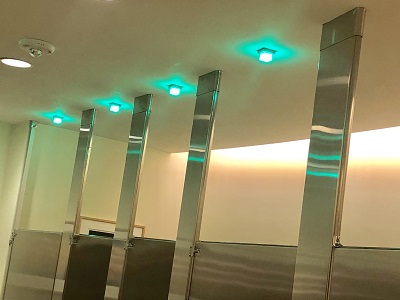|
January 2020
AutomatedBuildings.com
|
[an error occurred while processing this directive]
(Click
Message to Learn More)
|
As
I entered the third level of a parking garage, a green light lit up and
guided me to an open slot. IoT sensors in parking garages track the
movement of cars in and out of the parking slots to show us free
parking slots to save us time. Some garages count up the green lights
and tell us how many slots are open on which floor as we enter the
garage. Yesterday I saw this same technology deployed in a bathroom in
the auditorium building of a university — this time, the motion sensor
tracks people as they move in and out of stalls.
IoT sensors are creating new conveniences in buildings. It is very
helpful to see a red or green light on top of a stall to know if a
stall is empty in a restroom. Since all sensors collect data, the
provider of this sensor can collect this data on sensors turning red or
green and develop insights that are beyond the comprehension of
ordinary consumers. That is the double-edged sword of data.
John Rossman, author of 'The Amazon Way on IoT' inspired me on this
line of thinking with his thoughts about faucets being able to track
building occupancy. And now, seeing sensors tracking occupancy in
stalls got me thinking about what other building functions can benefit
from additional insights from this data.
When building sensor data is stored and analyzed, it can create more
uses for the building manager. For example, the bathroom sensor data
can give insight about peak usage of the restroom and which stall is
not being used and needs cleaning. A time series of this data can
inform the building owner of patterns of usage and can be used to
predict maintenance needs.

Image credit: Author
Here are some insights a building manager can glean from this bathroom sensor data:
- When is peak capacity of the stalls
can help plan for expansion or repair timings or estimate bathroom
supplies purchase and refills.
- How many people have used a particular stall can help optimize cleaning schedules.
- It can provide a real-time report if any stall is being avoided and can alert maintenance of a problem.
- It can provide a real-time headcount of people inside restrooms during an emergency lockdown or evacuations.
- It can provide reports on building occupancy for compliance to fire code.
Building Platforms harness data
Buildings have begun to off engagement platforms with Kone,
the elevator company creating voice engagement and customized displays
to be set up by the building clients. Voice is getting acceptance as
the interface for machine interfaces to humanize the AI gathering user
data behind it. Alexa has announced that they are working on learning
to use emotions from their voice interaction with Alexa voice assistant.
IoT data to building intelligence
Sensor
data can be combined with other data sources to provide training data
to build AI to develop predictive models to add intelligence to
buildings. For example, the HVAC system in the building can learn about
user movements in the building complex and decide to adjust the heat
setting to save energy usage. Or the voice interface in an elevator can
learn a user's mood to monitor the elevator safety of its building
residents.
What does this mean for Building owners?
[an error occurred while processing this directive]Building
owners have to think responsibly about the various use of data
over time and should plan whether they want a vendor to provide this
data as a service or is it something they want to own in-house.
What is the secret to the success of data in buildings?
Buildings are for people, and an unoccupied building has less value than the one with people. AIX, Designing AI experiences with data
is the secret to get user adoption. So it is important to invest in
creating the right user experience that will work for your customers.
Building automation with IoT sensors and voice will be successful
only if the design communicates to the users that their data is being
collected and gets their buy-in to make it a joint journey to find
acceptable uses of the data.
Next time the parking slot lights up I hope it will tell me if it is
tracking my preference of the same corner spot closest to the train
station entrance and I will tell it I would like it to give me that
spot on Wednesdays when I take the 9am train to San Francisco.
footer
[an error occurred while processing this directive]
[Click Banner To Learn More]
[Home Page] [The
Automator] [About] [Subscribe
] [Contact
Us]
